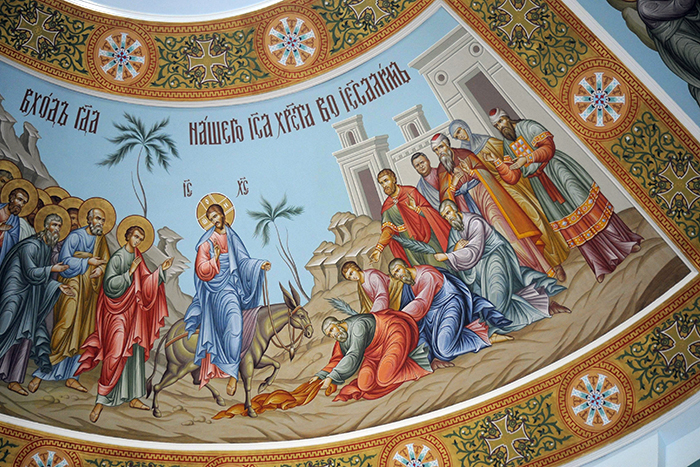
An interesting story recently appeared about a district official in Kazakhstan being depicted in a fresco at the new cathedral in the city of Rudny. Sergey Kulagin – former akim, or governor, of the Kostanai region – is apparently found among the crowd of Jews welcoming Jesus in the fresco of the Entrance into Jerusalem, freshly painted above the church altar.

The picture above shows the fresco in question, whilst below is a photograph of Mr Kulagin:

Since the story appeared, Sergey Kulagin has denied having anything to do with putting himself in the fresco and has even ordered the image to be repainted. He is quoted as saying:
“When we opened the church… I noticed a certain likeness. Of course, I told them to remove it immediately, to paint it over. Such things are unbecoming and unattractive, further still this is blasphemy.”
Neverthless, Sergey Kulagin is not the first living politician or ruler to appear in church iconography. It is a common feature of medieval churches, particularly those within the old Byzantine Empire, for those who paid for the building to be honoured in the frescoes. Quite often, as in the example of the 13th century Boyana church shown, the patron of the church is shown in profile, holding a model of the building in offering to Christ. Another example of this form is in the Chora church in Constantinople, where the 14th century court advisor Theodore Metochites donated substantial funds for restoration and is therefore honoured in this mosaic.
-

Donator portrait of Kalojan and his wife Desislava; Boyana church (Bulgaria, 13th century)
This image of benefactor offering a church building to Christ is very common in medieval churches and so is easily recognizable. It is a more striking and visible form of a foundation stone or plaque with the patron’s name engraved upon it.
However, like a foundation stone or plaque, its position in the building is key. In all the examples given above, the images of still-living church patrons all appear in towards the west of the church building, near the entrance. In the case of the mosaic of Emperor Justinian, made during his own lifetime, the image appears in the narthex – i.e. the porch of the church, outside the main building. The patrons are remembered in images, as much so they can be prayed for after death than anything else, but these images are not placed near the altar, on the iconostasis, in the sanctuary, or often even in the nave at all. These places are where images of the Saints, the angels, the Mother of God and Our Lord Jesus Christ are placed.
-

Mosaic of Justinian I in Basilica of San Vitala, Ravenna
In the case of the “Kulagin fresco”, however, the image appears in the main dome of the church. This is surely what the official was thinking of when he called the fresco of himself as “unbecoming and… blasphemous”. During the Liturgy, the words “Lift up your hearts…” are sung. Worshipers should look up and see paintings of Christ’s life which move them to remember the truths these events reveal. They should not look up and be distracted by thoughts of “Who’s that slightly pudgy guy without a beard? He looks familiar…” This is not how anyone who donates toward the building of churches would want to be remembered.




